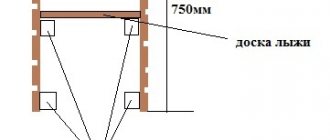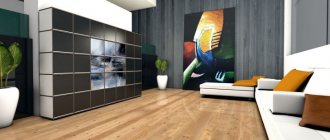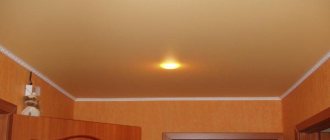Unfortunately, only after finishing the renovation in our new (or old) apartment, we understand that we should have started with completely different things, and that many mistakes could have been avoided “if only we knew...”.
But that’s why they are mistakes, to learn from them. True, it is not necessary to learn from your own: we study other people’s mistakes in repairs - and learn from them!
So, what mistakes do we make most often when renovating a kitchen?
- Floors. Wooden floors in the kitchen are always prone to dents from toys, falling lids, etc. Even if your children are super neat and the grasping reflex runs in your family, wood floors are still impractical. Today it is customary to lay laminate flooring in the kitchen, but usually the owners of such kitchens quickly become convinced that the decision made is wrong: the first leak (sink, refrigerator, etc.) - and the laminate swells.
- What about tiles? Tiles are a great solution for the kitchen! The main thing is not to make a mistake with color and texture. Dust and dirt are perfectly visible on dark tiles, and even wiping the floor every hour will not provide a feeling of cleanliness. And light tiles are too easily soiled. Also, you should not take tiles that are too smooth (slippery) or too textured/rough (they are extremely difficult to clean). The ideal option is a wide, matte tile with minimal relief and an optimal shade (so as not to stick out dirt and dust).
- Lighting. No need to skimp on light bulbs for the kitchen. There is always a lack of bright light in this room, so think in advance about how many light bulbs you need and in what places to “screw” them later. Be sure to pay attention to the area above the stove, the area above the dining table, and the area above the table where you actually cook (this area is the most important).
- Sockets. The main mistake of all new repairmen is saving on sockets. More precisely, the savings are small, but then the shortage of sockets is extremely acute. And it is in the kitchen that they will be missed most of all. Calculate exactly how many sockets you need based on your household appliances (existing and future). As a rule, the kitchen requires about 8 outlets (or even more) - a refrigerator and PMM, a microwave and a kettle, a coffee machine, etc. It is recommended to immediately make double sockets everywhere. And be sure to provide at least a couple of sockets above the worktop (right on the apron). When planning the number of sockets, also consider such a thing as a power reserve to service all devices.
- Protruding handles on furniture . Firstly, everyone will hit their knees (adults) and heads (children) against them. The kitchen owner will hit the handles on the upper cabinets. In addition, the more solid the handle, the smaller the opening angle of the door itself, and the more difficult it is to pull out the drawer.
- Ergonomics of space. Think carefully about the design of your kitchen in advance (!). It will be extremely difficult to redo the renovation once gas and water pipes have been installed, an apron and a hood have been made over the future stove. Consider the most important points: no labyrinths in the kitchen - it’s inconvenient! The main space should be free for quick easy movement, free opening of drawers, etc.
- Marble and other rough porous materials are not practical in the kitchen! Neither as a floor covering, nor for a countertop, nor for a sink. The porosity of the material ensures deep penetration of dirt and its difficult removal. It is better to choose artificial stone for the countertop.
- Facades . No gloss! Unless you have a lot of time to constantly scrub fingerprints off the gloss. Relief facades are also a headache. Scrubbing off dirt that has clogged up in the relief (especially white!) is difficult and time-consuming. White facades look chic, but over time the shade of the most frequently wiped areas on the furniture changes.
- Space for pots, lids, pans and household appliances . Immediately think through the cabinets in the lower part of the kitchen for all this beauty, so that later it does not fall on your head from the upper shelves.
- There should be no gaps between the stove (hob) and the countertop. Otherwise, everything you carry to the stove will spill onto the floor, and there will always be dirt on the floor between the stove and the cabinet.
- The apron is made only from fire-resistant materials! Wallpaper, even if very beautiful, must be protected with special glass. Leave the polypropylene finish for other rooms - it will simply melt. Choose materials for your apron that do not burn, do not melt, do not release poisons into the air when heated, and do not deteriorate from exposure to household chemicals.
- Backsplash tiles. The deeper and wider the seams, the more dirt they contain, which is difficult to wash out over the entire area above the kitchen work surface. White grout is another big mistake for beginners; it is difficult to clean, and dirt is clearly visible. The ideal option is absolutely smooth, not glossy and not too textured tiles with minimal seams.
- Washing. If you choose a sink that is too small, you will constantly see a mountain of dishes right on the table. A sink without a wing is a constant “sea” around the sink. It is convenient to place cups and other dishes that drain after washing on the sink wing.
- Walls. If you're going to hang heavy cabinets in your kitchen, make sure the walls can support them. Naturally, a plasterboard partition will not support such furniture - it needs to be strengthened in advance. It is recommended to immediately provide places throughout the apartment that may require additional reinforcement - under the TV, under shelves, etc.
- Do not place the stove next to the refrigerator! Even if there is not enough space, look for another option. Otherwise, your wonderful, fashionable refrigerator will have a long life in the shortest possible time.
So, renovating rooms - living room, bedroom, children's room - what mistakes to avoid?
- Don't leave the old wiring behind. If it was made during the reign of Tsar Gorokh, do not spare money for a new one. So as not to later open the repaired walls in search of an area with a short circuit. It is important to note that in old apartments, where there has been no renovation since Soviet times, the wiring can run in a completely unpredictable way, even diagonally. That is, when hanging a shelf, you may accidentally hit the wires with a puncher. Only new wiring will help you avoid problems - done according to all the rules, by professionals, and marked on the drawings, which you will then use to guide yourself. Important! First, carefully think through the plan for arranging the furniture, so that later you suddenly don’t find that there is not a single socket near the bed, not one at the desk, and as many as five behind the closet.
- Shield and individual machines. When making electrical wiring, install a machine in each room (plus it is recommended separately for the boiler and washing machine). Firstly, you will know exactly which room caused the plug to break due to overvoltage, and secondly, you will not have to turn off the power to the entire apartment if any electrical work is necessary.
- Warm floor. All “victims” of renovations begin to regret the lack of heated floors with the arrival of autumn. Even in the southern regions. Warm floors won’t cost you a lot of money and energy, but the whole family will thank you from morning to evening, calmly plopping barefoot even on the tiles in the bathroom. Install heated floors wherever you walk barefoot. Naturally, with a timer.
- If children are growing up in the family, install switches at the required height so that the children can cope with this function themselves.
- If you don’t have “closets” (Soviet closets) and your own veranda and shed, and you don’t even have a loggia where you can put everything unnecessary, then think about a place in the apartment for things that require storage - suitcases and vacuum cleaners, sleds and strollers, New Year’s Christmas trees with toys, etc. All this needs to be stored somewhere. Where? Stock up ahead of time!
- Soundproofing. If your house is not of the Stalinist type - with thick walls - start with soundproofing. Otherwise, later you will greatly regret listening from two sides (or even three) every evening to concerts of neighboring teenage musicians, young children and depressed adults. Use special materials (fortunately, there are no shortcomings in them today) that have similar characteristics. If you have children and dogs living with you, and your housewives love to click their heels around the apartment, then think about your neighbors downstairs too - do soundproofing before installing the floors.
- Flooring. Carpet is a warm and pleasant covering for feet. But it creates a lot of dust, it is impossible to wash it, it gets dirty quickly, and it can cause allergies. If you don’t have a special cleaning vacuum cleaner with steam treatment and a lot of free time, choose other coatings. Cork flooring is pleasant, environmentally friendly, natural, and is not afraid of moisture. The downside is that there are traces of furniture on the cork and, in general, cork is absolutely not practical for rooms where life is in full swing. What flooring to choose for a children's room?
- Forgetting to make an additional switch near the bed , you doom yourself to get out of your warm bed every evening to turn off the light. By the way, don't forget to install the switch at the door in the right place. So that when you enter a room, you can immediately feel it with your hand.
- Big beautiful chandeliers are great! But it is much more convenient (in practice) when you have several light sources in the room - a bright chandelier, spotlights, several sconces and a floor lamp, table lamps.
- Do not hang heavy cabinets or shelves on your bed. Of course, the master can fix the shelves “tightly”, and you will only place “light” objects on it. But, as a rule, sooner or later something falls on your head. And it’s good if it’s a teddy bear, and not a stack of books or the shelf itself.
Bathroom and plumbing
Do not skimp on plumbing and finishing materials.
The bathroom and toilet are the most problematic areas of renovation.
In order not to re-tile the tiles several times, first replace all old communications, check the location of the toilet, bathtub, sink, washing machine, water heater and heated towel rail.
Also think about heated floors in advance. We also recommend buying a little more tiles for the bathroom than necessary - perhaps after a while they will be discontinued, so you will have to redo the entire bathroom.
High-quality materials and new communications will increase the cost of an apartment or house, so saving on them is a mistake in repairs and the threat of quick alterations.
Video: Mistakes made when renovating bathrooms and toilets
- And again the sockets. It would seem – why in the bathroom! Can I throw in an extension cord? No extension cords in the bathroom - it's dangerous! Install the sockets in advance (and with covers against moisture!), so that later you don’t have to pierce the walls directly over the new tiles. Immediately think about sockets for a hair dryer, washing machine, electric heated towel rail (if you don’t have a classic one) and other needs.
- Do not combine a bathtub and a toilet if space allows you not to do so.
- Lack of waterproofing can cost you a pretty penny if your washing machine suddenly breaks down or you forget to turn off the tap in the bathroom. Don't skimp on waterproofing!
- Do not lay glossy, slippery tiles in the bathroom - this is dangerous . Black tiles (and dark shades in general) for the bathroom are a big mistake. On black tiles (and earthenware!) all the stains, stains, dust, and dirt are visible.
- Choose expensive plumbing fixtures right away . Then it will be very disappointing when the toilet becomes covered with small cracks and the acrylic bathtub turns yellow.
- Forced exhaust . Even if you have a dry and warm apartment, forced exhaust (which will turn on along with the light in the bathroom and toilet) in the bathroom is protection against mold and odors.
- Pipe routing . Trust the work only to a master! In addition to the fact that the pipe layout in the bathroom must be of high quality, you need to take into account both the angle of inclination and high-quality drainage.
- Do not block access to communications! This is the most common mistake during repairs. Leave beautiful (and large!) plastic windows, which in case of an “accident” will provide access under the bathtub, to taps and pipes.
- One lamp in the bathroom will not be enough - add additional light near the mirror, but taking into account protection from moisture.
- Stretch ceilings will save you from a neighbor's flood. Suspended ceilings in the bathroom are a waste of money.
Top 10 mistakes when renovating an apartment
Below are the most typical repair “blunders” that can ruin the impression of the updated interior.
Mistake No. 1. Lack of a clear action plan.
When starting a renovation, you should clearly understand the types of finishes that will be used, select lamps, doors, plumbing fixtures, household appliances and furniture. Every accessory must be taken into account.
If, for example, curtains will be hung on a cornice, you need to allocate a place for it. For long curtains, you need to calculate the appropriate dimensions of the heating radiator so that they do not lie on it and do not bulge. For short tulle, install a cornice that is at least 5 cm wider than the window on each side. Otherwise, the canvas will not cover the window at the edges, leaving gaps.
There are many similar nuances. And if a professional design project is not included in the budget for your renovation, you should think through every detail of the future interior yourself, listening to the recommendations of specialists.
Mistake No. 2. Excessive savings on rough finishing.
The rough finish is the “body” of the apartment, which is then “dressed” in the final finish – materials, furniture and decor. The quality of all repairs depends on it. Therefore, excessive savings will not only negatively affect the appearance of the future interior, but will also lead to additional expenses later. It is very problematic to correct or complete a poor-quality rough finish. This mistake is especially common when renovating apartments in new buildings.
Even if you save on rough finishing to purchase more expensive finishing materials and furniture, it is quite possible that the renovation will still not look high quality. It is better to initially entrust the rough finishing to professionals than to later face pitfalls when it will no longer be possible to fix something.
For example, the curvature of the walls or sloppy joints on the ceiling will appear only when finishing coatings (paint, wallpaper) are applied and when the electric lighting is turned on. Not to mention expensive decorative plaster, which requires impeccable smoothness of the painted surfaces. High-quality faucets will quickly fail from water containing impurities if you neglect to install filters and manifold units. And a stylish chandelier and the most expensive household appliances will not be able to please the owners if, when they are turned on, the electric machine constantly knocks out.
Mistake No. 3. Inability to plan repair costs.
Having purchased an apartment or erected the walls of a future home, the owners begin to think through the future interior with inspiration. They look at magazines, design websites and rush to the shops, primarily for furniture.
This approach can be risky and reckless. Of course, equipping a new home in advance with the necessary finishing materials, appliances and furniture is the right and reasonable step. But there is no need to do this hastily. Buying a sofa or carpet before selecting finishing materials for the floor, or making an advance payment for a kitchen unit before agreeing on the layout of the apartment and the corresponding measurements is not the best idea.
Modern marketing and advertising technologies do not leave consumers the slightest chance to refuse a purchase. Store employees trained at seminars and sales trainings will definitely say that they have the most unique quality furniture and there is no need to put off the purchase for a long time, since “the models you like are running out of stock,” “the promotion is running out,” “only today and just now” and so on.
All techniques are aimed at pushing the buyer to make a quick decision in favor of a particular store. Of course, you can really save money on sales. But only if you buy an exhibition sample from the showroom or leftovers from the warehouse at half price. Sometimes the store offers a discount of up to 90%. In this case, you need to look at prices for promotional items from other sellers. If the same furniture in other salons is really more expensive, then you should think about buying it.
In other cases, the budget must be distributed in stages:
- materials for rough finishing and payment for related work;
- entrance doors;
- plumbing fixtures and installation fees;
- electrical (only built-in lamps without chandeliers), rough materials and installation services;
- finishing materials;
- interior doors.
These purchases must be made immediately, and, having allocated funds for them, you can begin to spend the rest.











